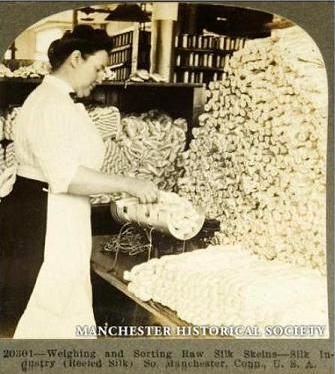



So. Manchester, Conn., U.S.A.
The manufacture of silk starts with the reeling of the fine threads from the unpierced cocoons in which the moths have been killed by heat. These threads are made up into skeins, known as raw or reeled silk. Practically no raw silk is produced in the United States. During the year 1912, $80,000,000 worth of raw silk was imported into the United States. The countries from which the raw material is imported are Japan, China, and Italy.
This picture gives us a much closer view of the raw silk as it arrives. The first handling of the raw material is naturally that of weighing and assortnig the skeins.
The Japanese Government, as early as 1896, opened a conditioning house at Yokohama for the purpose of weighing the raw silk and determining its quality. This was done by the government to foster a Japanese export trade in raw silk. The Japanese conditioning establishment has the following functions:
(1) To determine the net weight of silk.
(2) To determine the condition weight of silk; that is, to determine its condition in respect to absorbed water, as silk in a raw state absorbs a large amount of moisture without being manifestly damp, thus making considerable difference in the weight.
(3) To examine the number of breakages by means of re-reeling the silk, and to determine the rate of such breakages per reel.
(4) To ascertain the denier or size as indicated by the number of yards of thread per pound.

 )
)